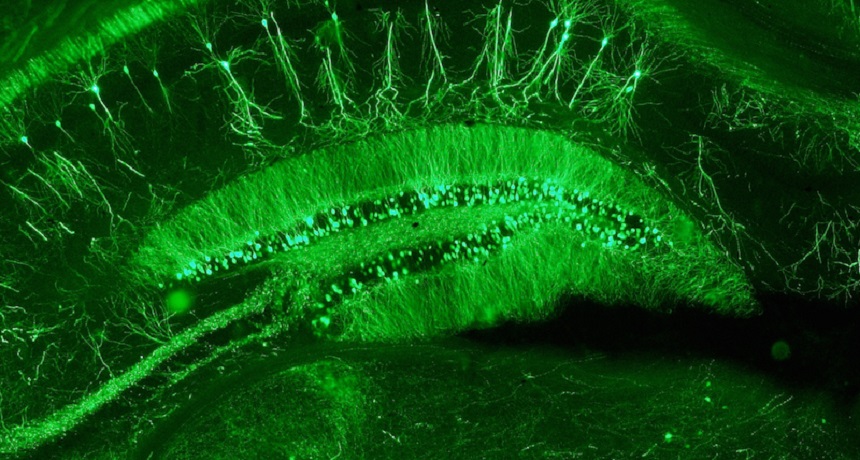Scans show aging brains can leak
The barrier between the brain and the blood can degrade as a person gets older

With age, the blood-brain barrier weakens. The first signs of this show up in the hippocampus. That tissue, here shown in a mouse, helps store memories. Scientists inserted a gene into this mouse to make its hippocampal cells glow green.
Hadley Bergstrom/NIAAA
A protective network of cells surrounds blood vessels in the brain. This blood-brain barrier shields the brain from dangerous stuff that might be moving through the bloodstream. But the barrier doesn’t remain intact forever. Brain scans now show that the barrier starts to leak as people age. That lets compounds that the barrier once kept out now enter.
The scans suggest the barrier’s breakdown may play an important role in Alzheimer’s disease. The reason: Brains in aging people get leaky first in areas used in learning and memory, the scans showed.
Aging and memory problems already had been linked to leakier blood-brain barriers. However, no one had shown this link in brain scans from living people.
Costantino Iadecola calls the findings a “major advance.” A neuroscientist at the Weill Cornell Medical College in New York City, he did not work on the new study. The new study suggests the blood-brain barrier should be studied “as a factor contributing to dementia,” he told Science News.
Neuroscientist Berislav Zlokovic at the University of Southern California in Los Angeles led the new study. His team compared brain scans from 63 people of different ages taken with magnetic resonance imaging, or MRI. This technology uses magnetic fields to create images of tissues inside the body.
The new MRI scans tracked an element called gadolinium in healthy people aged 23 to 91 years old. Scientists sometimes inject this element into the blood. There it can serve as a marker to track precisely where blood flows. Here, Zlokovic’s team watched as it passed through the blood-brain barrier.
The barrier’s leakiness first showed up in the hippocampus. This region is important for learning and memory. And leaks were more likely to show up in older brains.
In addition, people 55 to 85 years old with some memory problems tended to have leakier blood-brain barriers than did healthy people their age. Zlokovic’s team reported its new findings on January 21 in the journal Neuron.
“This is very important work,” says Gary Rosenberg. A neuroscientist at the University of New Mexico in Albuquerque, he did not work on the study. Researchers now need to identify when these changes occur in the timeline of dementia related to Alzheimer’s, he told Science News.
The new study suggests a kind of chicken-and-egg problem, Iadecola says. He means it’s not clear which came first. The breakdown may lead to a leakage of chemicals and the development of Alzheimer’s. Or Alzheimer’s may be what first causes damage to the blood-brain barrier. The next step is for researchers to figure out which is the cause and which the effect.
Power Words
(for more about Power Words, click here)
Alzheimer’s disease An incurable brain disease that can cause confusion, mood changes and problems with memory, language, behavior and problem solving. No cause or cure is known.
blood-brain barrier A barrier of tightly packed cells that carefully regulate what molecules can — and can’t — enter the brain. The barrier protects the brain from foreign substances in the blood and helps to maintain a constant environment for brain cells.
brain scan The use of an imaging technology, typically using X rays or a magnetic resonance imaging (or MRI) machine, to view structures inside the brain. With MRI technology — especially the type known as functional MRI (or fMRI) — the activity of different brain regions can be viewed during an event, such as viewing pictures, computing sums or listening to music.
cell The smallest structural and functional unit of an organism. Typically too small to see with the naked eye,it consists of watery fluid surrounded by a membrane or wall. Animals are made of anywhere from thousands to trillions of cells, depending on their size.
chemical A substance formed from two or more atoms that unite (become bonded together) in a fixed proportion and structure. For example, water is a chemical made of two hydrogen atoms bonded to one oxygen atom. Its chemical symbol is H2O.
dementia A type of mental disorder caused by disease or injury that causes people to gradually lose all or part of their memory. It may start out temporary and build to a permanent condition where the ability to reason also is impaired.
element (in chemistry) Each of more than one hundred substances for which the smallest unit of each is a single atom. Examples include hydrogen, oxygen, carbon, lithium and uranium.
hippocampus A seahorse-shaped region of the brain. It is thought to be the center of emotion, memory and the involuntary nervous system.
magnetic field An area of influence created by certain materials, called magnets, or by the movement of electric charges.
magnetic resonance imaging (MRI) An imaging technique to visualize soft, internal organs, like the brain, muscles, heart and cancerous tumors. MRI uses strong magnetic fields to record the activity of individual atoms.
neuroscience Science that deals with the structure or function of the brain and other parts of the nervous system. Researchers in this field are known as neuroscientists.
technology The application of scientific knowledge for practical purposes, especially in industry — or the devices, processes and systems that result from those efforts.







